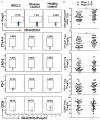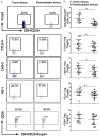Increased expression of immunosuppressive molecules on intratumoral and circulating regulatory T cells in non-small-cell lung cancer patients
- PMID: 26328249
- PMCID: PMC4548330
Increased expression of immunosuppressive molecules on intratumoral and circulating regulatory T cells in non-small-cell lung cancer patients
Abstract
The expression patterns of immunosuppressive molecules on regulatory T (Treg) cells have not been elucidated in non-small-cell lung cancer (NSCLC) patients. In this study, a total of 88 patients including 53 patients with NSCLC, 17 patients with lung non-malignant diseases, and 18 healthy volunteers were enrolled. Increased number of total CD4(+)CD25(+)FoxP3(+) Treg cells and elevated expressions on the surface of several inhibitory molecules including CTLA-4, LAG-3 and PD-1 have been observed in the peripheral blood of NSCLC patients. We found that intratumoral Treg cells from NSCLC patients express the highest levels of co-inhibitory molecules compared to Treg cells isolated from tumor adjacent tissues or from peripheral blood of cancer patients, which is in consistent with the enhanced immunosuppressive function of these co-inhibitory molecules. Moreover, the number of Treg cells and their functional surface molecules increased during the progression of lung cancer. Elevated plasma levels of TGF-β and IL-10 in NSCLC patients were also observed in NSCLC patients compared to that in healthy volunteers. Our findings further support the role of Treg cells in the tumor microenvironments in NSCLC patients.
Keywords: Regulatory T cells; immunosuppressive molecules; non-small-cell lung cancer; tumor-infiltrating lymphocytes.
Figures





Similar articles
-
Effect of TGF-β1 on blood CD4+CD25high regulatory T cell proliferation and Foxp3 expression during non-small cell lung cancer blood metastasis.Exp Ther Med. 2018 Aug;16(2):1403-1410. doi: 10.3892/etm.2018.6306. Epub 2018 Jun 13. Exp Ther Med. 2018. PMID: 30112067 Free PMC article.
-
[Expression levels of co-inhibitory molecules CTLA-4, LAG-3, PD-1 and CD39 on CD4⁺ T cells correlate with progression of non-small cell lung cancer].Zhonghua Zhong Liu Za Zhi. 2014 Jun;36(6):424-9. Zhonghua Zhong Liu Za Zhi. 2014. PMID: 25241783 Chinese.
-
Elevated Circulating CD4+CD25-Foxp3+ Regulatory T Cells in Patients with Nonsmall Cell Lung Cancer.Cancer Biother Radiopharm. 2019 Jun;34(5):325-333. doi: 10.1089/cbr.2018.2672. Epub 2019 Mar 29. Cancer Biother Radiopharm. 2019. PMID: 30925076
-
[The role of regulatory T cells in the modulation of anti-tumor immune response].Srp Arh Celok Lek. 2013 Mar-Apr;141(3-4):262-7. doi: 10.2298/sarh1304262r. Srp Arh Celok Lek. 2013. PMID: 23745355 Review. Serbian.
-
The Molecular Role of IL-35 in Non-Small Cell Lung Cancer.Front Oncol. 2022 May 26;12:874823. doi: 10.3389/fonc.2022.874823. eCollection 2022. Front Oncol. 2022. PMID: 35719927 Free PMC article. Review.
Cited by
-
Ring finger protein 31-mediated atypical ubiquitination stabilizes forkhead box P3 and thereby stimulates regulatory T-cell function.J Biol Chem. 2018 Dec 28;293(52):20099-20111. doi: 10.1074/jbc.RA118.005802. Epub 2018 Nov 2. J Biol Chem. 2018. PMID: 30389786 Free PMC article.
-
New emerging targets in cancer immunotherapy: the role of LAG3.ESMO Open. 2019 Mar 12;4(2):e000482. doi: 10.1136/esmoopen-2018-000482. eCollection 2019. ESMO Open. 2019. PMID: 31231559 Free PMC article. Review.
-
Age-related changes in CD4+CD25+FOXP3+ regulatory T cells and their relationship with lung cancer.PLoS One. 2017 Mar 2;12(3):e0173048. doi: 10.1371/journal.pone.0173048. eCollection 2017. PLoS One. 2017. PMID: 28253320 Free PMC article.
-
Immunological Correlates of Response to Immune Checkpoint Inhibitors in Metastatic Urothelial Carcinoma.Target Oncol. 2018 Oct;13(5):599-609. doi: 10.1007/s11523-018-0595-9. Target Oncol. 2018. PMID: 30267200
-
The Next-Generation Immune Checkpoint LAG-3 and Its Therapeutic Potential in Oncology: Third Time's a Charm.Int J Mol Sci. 2020 Dec 23;22(1):75. doi: 10.3390/ijms22010075. Int J Mol Sci. 2020. PMID: 33374804 Free PMC article. Review.
References
-
- Nishikawa H, Sakaguchi S. Regulatory T cells in cancer immunotherapy. Curr Opin Immunol. 2014;27:1–7. - PubMed
-
- He S, Li M, Ma X, Lin J, Li D. CD4+CD25+Foxp3+ regulatory T cells protect the proinflammatory activation of human umbilical vein endothelial cells. Arterioscler Thromb Vasc Biol. 2010;30:2621–30. - PubMed
-
- Liang B, Workman C, Lee J, Chew C, Dale BM, Colonna L, Flores M, Li N, Schweighoffer E, Greenberg S, Tybulewicz V, Vignali D, Clynes R. Regulatory T cells inhibit dendritic cells by lymphocyte activation gene-3 engagement of MHC class II. J Immunol. 2008;180:5916–26. - PubMed
LinkOut - more resources
Full Text Sources
Research Materials
